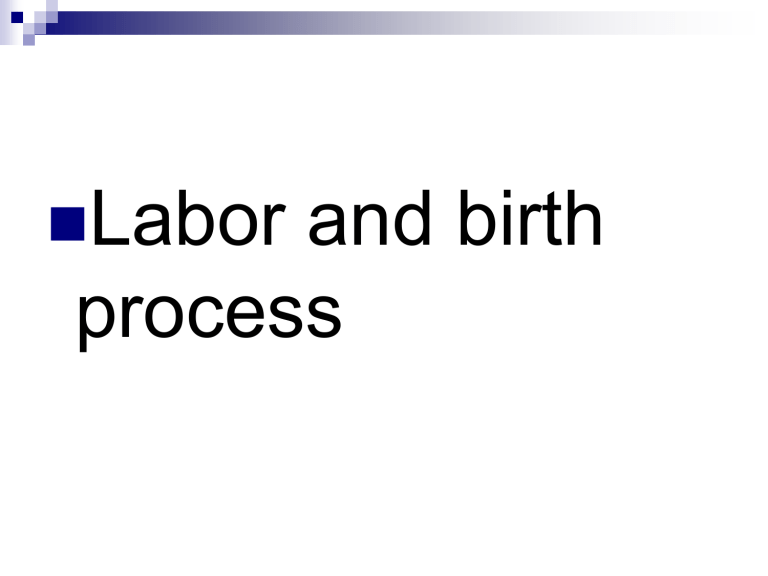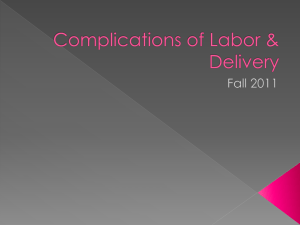Labor Process

Labor and birth process
Labor Process
Exact mechanism unknown
Theories:
Uterine stretching
Prostaglandin
Oxytocin stimulation
Cervical pressure
Aging placenta
Increased fetal cortisol levels
Signs of labor
Lightening
Increased level activity
Weight loss
Braxton hicks contractions
Cervical changes
Uterine contractions
Bloody show
Rupture of membranes
True labor verses False labor
Differentiated ONLY by cervical changes:
Dilation
Effacement
Components of labor
3.
4.
5.
1.
2.
Passage
Passenger
Power
Psyche
Placenta
Passage
Route fetus must travel from uterus to perineum
Shape of pelvis
Gynecoid
Anthropoid
Android
Platypelloid
Passage
Bony structures
Joints, bones
False pelvis
True pelvis
Pelvic diameters
Diagonal conjugate
Soft tissues
Passenger
Fetal skull
Bones
Suture lines
Fontanelles
Diameter
Molding
Passenger
Presentation – fetal body part that will be first to pass through cervix
Affects duration and difficulty of labor
Affects method of labor
Describe as variations of:
Cephalic- vertex, brow, sinciput, mentum
Breech – complete, frank, incomplete, footling
Shoulder – shoulder, iliac crest, hand, elbow
Passenger
Lie – refers to relationship of long axis
(spine) of fetus to long axis of mother
Longitudinal
Cephalic, breech
Transverse
Horizontally, side to side
Oblique
45 degree angles
Passenger
Attitude
Complete flexion – chin to chest
Moderate flexion – military
Partial extension – brow
Complete extension - face
Passenger
1.
2.
1.
2.
3.
Position – relationship of presenting part of fetus to specific section of mother’s pelvis
Patient’s pelvis – 4 sections
Right anterior
Left anterior
Right posterior
4.
Left posterior
Fetus parts –
1.
Occiput (O) – vertex
2.
3.
4.
Mentum (M)- face
Sacrum (S) – breech
Acromion (A) - shoulder
Passenger position
Fetal position described by using three letters:
1.
First letter defines whether fetal landmark pointing to mother’s right or left
2.
3.
4.
1.
Second letter designates fetal landmark
Occiput(O), mentum(M), sacrum(Sa), Acromion(A)
Last letter defines whether landmark points anteriorly(A), posteriorly(P), or transverse(T)
LOA – left occiput anterior most common
Passenger
Station – relationship of presenting part to ischial spine of mother
-5 (pelvis)to +4(perineum)
Station 0 is at level of ischial spines – engagement occurs
Floating, ballotable
crowning
Cardinal movements of labor
4.
5.
6.
7.
1.
2.
3.
Number of fetal position changes as travels through birth canal
Engagement
Decent
Flexion
Internal rotation
Extension
External rotation
Expulsion
Power
Force of uterine contractions
Contractions of abdominal muscles
Contraction pattern
Begin pacemaker point upper uterine segment
Wavelike pattern relaxation
Phases:
Increment
Acme
Decrement
Duration
Contour changes
Power
Cervical changes – increased diameter of cervical canal and lumen occurs by pulling cervix up over present part with uterine contractions
Effacement – shortening and thinning of cervical canal
% - 0 to 100%
Dilation – enlargement of cervical canal from
1 to 10cm
Psyche / Psychological Response
Feeling woman brings to labor
Psychological readiness for labor
Factors affecting
Preparation
Support person
Past experiences
Task of pregnancy
Situational control
Maternal Position
Philosophy of Childbirth
Partners
Patience
Patient Preparation
Maternal physiologic response to labor
Cardiovascular
Fluid and electrolyte
Respiratory
Hematopoietic
GI
Renal
Musculoskeletal
neurologic
Fetal Response to Labor
Healthy fetus adapts to stress of labor
Periodic fetal heart rate changes
Circulation
Increase PCO2
Decrease Partial PO2
Decrease fetal breathing movements
Stages of labor
3.
4.
1.
2.
Dilation – 0 to 10 cm
Expulsion
Placental
Immediate postpartum
Dilation
Begins with true labor contractions ends with complete cervical dilation
Divided into 3 phases
1.
Latent: 0-3cm
2. Active: 4-6cm
3. Transitional: 7-10cm
Latent Phase
Preparatory phase
Contractions mild and short 30-40sec
Dilation 0-3cm
4-6 hours
Analgesia too early prolongs phase
Walking, packing, preparing
Active Phase
Working phase
4-6cm
Contractions stronger, 40-60 sec, every 3 to 5 min
True discomfort
2-4 hours
Rupture of membranes
Analgesia little effect on progress of labor
Transition phase
Feeling of loss of control occurs here
7-10cm
Contractions peak intensity 2-3 min
90 second duration
Feelings of urge to push
Intense discomfort, nausea, vomiting, anxiety, panic, irritability
Focus inward on task of birth
Expulsion
Full dilation and effacement to birth of infant
20 min to 2 hours
Fetus moved by “cardinal movements of labor
Uncontrollable urge to push with contractions 2-3 min n/v, perspires, distended blood vessels, petechae
Perineum bulge
Inverted anus crowning
Placental
Birth of infant to delivery of placenta
Placental separation
Bleeding on maternal side
Lengthening of umbilical cord
Gush vaginal blood
Change shape of uterus
Presentation:
Shiny schultz
Dirty duncan
Immediate post-partum
3 hours after delivery
Stabilizing Mom
Bleeding, bp, perineum, uterus, pain
Stabilizing baby
Acclimated extrautering life
Promoting bonding
Bleeding, bp, perineum, uterus, pain
Nursing Management
Nursing Management during labor and birth
Assessments
Maternal
Vaginal Exam - Dilation, effacement, station, membranes
Contraction pattern
Contraction patterns
Phases
Duration
Frequency
intensity
Assessments
Fetal
Position – Leopold’s maneuvers
Amniotic fluid
Electronic fetal monitoring
Intermittent
Continuous
External
Internal
Fetal heart rate patterns
Baseline Fetal Heart Rate
Baseline variability
Increased variability
Decreased variability
Periodic Baseline Changes
Accelerations
Decelerations
Early
Late
Variable
Other Fetal Assessment Methods
Fetal Pulse Oximetry
Fetal Stimulation
Scalp Ph
Providing comfort
Etiology of pain
Perception
Fetal position
Nonpharmacologic Measures
Labor Support
Ambulation / Position Changes
Acupuncture / pressure
Focused Imagery
Breathing Techniques
Therapeutic touch / Massage
Effleurage
Pharmacologic
Systemic
IV, IM, PO
Regional
Epidural
Spinal
Regional block
Local
General
Nursing Care
Admission assessment
Continual Assessment
First Stage
Second, Third, Fourth Stage
Nursing care
VS
I&O
Pain
Emotional support
Sterile technique
Teaching
cleanliness
Nursing care
calm environment
Clear liquids
Output
Ambulate
Involve support person
IV-blood samples
Position changes
Breathing techniques
Perineal care
Monitor contractions
Monitor FHR
VE
Nursing Care During First Stage of Labor
General measures
Obtain admission history
Check results of routine laboratory tests and any special tests
Ask about childbirth plan
Complete a physical assessment
Initial contact either by phone or in person
First Stage of Labor: Phone Assessment
Estimated date of birth
Fetal movement; frequency in past few days
Other premonitory signs of labor experienced
Parity, gravida, and previous childbirth experiences
Time frame in previous labors
Characteristics of contractions
Bloody show and membrane status (whether ruptured or intact)
Presence of supportive adult in household or if she is alone
First Stage of Labor: Admission Assessment
Maternal health history
Physical assessment (body systems, vital signs, heart and lung sounds, height and weight)
Fundal height measurement
Uterine activity, including contraction frequency, duration, and intensity
Status of membranes (intact or ruptured)
Cervical dilatation and degree of effacement
Fetal heart rate, position, station
Pain level
First Stage of Labor: Admission Assessment
(cont’d)
Fetal assessment
Lab studies
Routine: urinalysis, CBC
HbsAg screening, GBS, HIV (with woman’s consent), and possible drug screening if not included in prenatal history
Assessment of psychological status
First Stage of Labor: Continuing
Assessment
Woman’s knowledge, experience, and expectations
Vital signs
Vaginal examinations
Uterine contractions
Pain level
Coping ability
FHR
Amniotic fluid
Nursing Management: Second
Stage
Assessment
Typical signs of 2 nd stage
Contraction frequency, duration, intensity
Maternal vital signs
Progress of labor, crowning
Fetal response to labor via FHR
Amniotic fluid with rupture of membranes
Coping status of woman and partner
Nursing Management: Second Stage
Interventions
Supporting woman & partner in active decision-making
Supporting involuntary bearing-down efforts; encouraging no pushing until strong desire or until descent and rotation of fetal head well advanced
Providing instructions, assistance, pain relief
Using maternal positions to enhance descent and reduce pain
Preparing for assisting with delivery
Nursing Management: Second
Stage
Interventions with birth
Cleansing of perineal area and vulva
Assisting with birth, suctioning of newborn, and umbilical cord clamping
Providing immediate care of newborn
Drying
Apgar score
Identification
Nursing Management: Third
Stage
Assessment
Placental separation; placenta and fetal membranes examination; perineal trauma; episiotomy; lacerations
Interventions
Instructing to push when separation apparent; giving oxytoxic if ordered; assisting woman to comfortable position; providing warmth; applying ice to perineum if episiotomy; explaining assessments to come; monitoring mother’s physical status; recording birthing statistics; documenting birth in birth book
Nursing Management: Fourth Stage
Assessment
Vital signs, fundus, perineal area, comfort level, lochia, bladder status
Interventions
Support and information
Fundal checks; perineal care and hygiene
Bladder status and voiding
Comfort measures
Parent-newborn attachment
Teaching






